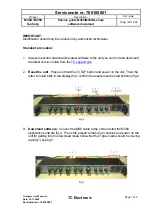
216
To do…
Use the command…
Remarks
Apply an import routing policy
import route-policy
route-policy
Optional
By default, all routes matching the
import target attribute are
accepted.
Apply an export routing policy
export route-policy
route-policy
Optional
By default, routes to be advertised
are not filtered.
NOTE:
•
Route related attributes configured in VPN instance view are applicable to both IPv4 VPNs and IPv6
VPNs.
•
You can configure route related attributes for IPv4 VPNs in both VPN instance view and IPv4 VPN view.
Those configured in IPv4 VPN view take precedence.
•
A single
vpn-target
command can configure up to eight VPN targets. You can configure up to 64 VPN
targets for a VPN instance.
•
You can define the maximum number of routes for a VPN instance to support, preventing too many
routes from being redistributed into the PE.
•
The routing policy associated with a VPN instance must have been configured. Otherwise route filtering
does not take effect.
Configuring a tunneling policy for a VPN instance
When multiple tunnels exist in an MPLS L3VPN network, you can configure a tunneling policy to specify
the type and number of tunnels to be used by using the
tunnel select-seq
command or the
preferred-path
command.
With the
tunnel select-seq
command, you can specify the tunnel selection preference order and the
number of tunnels for load balancing.
With the
preferred-path
command, you can configure preferred tunnels that each correspond to a tunnel
interface.
After a tunneling policy is applied on a PE, the PE selects tunnels in this order:
•
The PE matches the peer PE address against the destination addresses of preferred tunnels, starting
from the tunnel with the smallest number. If no match is found, the local PE selects tunnels as
configured by the
tunnel select-seq
command or the default tunneling policy if the
tunnel select-seq
command is not configured. The default tunneling policy selects only one tunnel (no load balancing)
in this order: LSP tunnel, CR-LSP tunnel.
•
If a matching tunnel is found and the tunnel is available, the local PE stops matching other tunnels
and forwards the traffic to the specified tunnel interface.
•
If the matching tunnel is unavailable (for example, the tunnel is down or the tunnel’s ACL does not
permit the traffic) and is not specified with the
disable-fallback
keyword, the local PE continues to
match other preferred tunnels; if the tunnel is specified with the
disable-fallback
keyword, the local
PE stops matching and tunnel selection fails.
To configure a tunneling policy for a VPN instance:
To do…
Use the command…
Remarks
Enter system view
system-view
—
















































